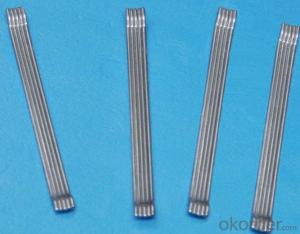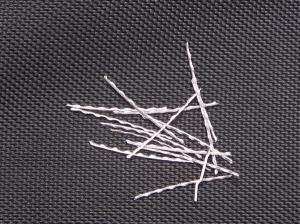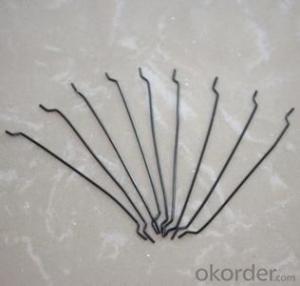Melt Extract Stainless Steel Fiber - Straight Type CNBM International from China
- Loading Port:
- Tianjin
- Payment Terms:
- TT OR LC
- Min Order Qty:
- 1000 kg
- Supply Capability:
- 30000 kg/month
OKorder Service Pledge
OKorder Financial Service
You Might Also Like
Quick Details
Place of Origin: Jiangsu, China (Mainland)
Model Number: HT-ST
Material: Steel
Specifications
1.Diameter:0.4mm-1.2mm
2.Length: 25mm-60mm
3.Material: low carbon steel wire
4.Feature: excellent tensile,high tenacity,against cracking,impact and fatigue
5.Uses: highway,tunnel,building,airport road serface and so on .
Steel Fiber Specification :
MODEL | DIAMETE(mm) | LENGTH(mm) | ASPECTRATIO(mm) | TENSILE STRENGTH(Mpa) |
YS-60/60 | 1 | 60 | 60 | ≥1000Mpa |
YS-50/50 | 1 | 50 | 50 | ≥1000Mpa |
YS-65/60 | 0.9 | 60 | 65 | ≥1000Mpa |
YS-55/50 | 0.9 | 50 | 55 | ≥1000Mpa |
YS-80/60 | 0.75 | 60 | 80 | ≥1000Mpa |
YS-45/35 | 0.75 | 35 | 45 | ≥1000Mpa |
YS-55/30 | 0.55 | 30 | 55 | ≥1000Mpa |
YS-60/30 | 0.5 | 30 | 60 | ≥1000Mpa |
YS-50/25 | 0.5 | 25 | 50 | ≥1000Mpa |
YS-60/25 | 0.4 | 25 | 60 | ≥1000Mpa |
Picture

Steel fiber straight type


FAQ
certificated: ISO 9001
Technical advantages of Daye steel fiber:
A. Improve mechanical performance of concrete
B. Provide uniform distribution throughout concrete with excellent mixing
C. No balling or caking by adopt correct mixing method
D. Reduce concrete volume
E.Save construction time and cost
F.Reduce excavation volume
G.Available for jointless floor.
- Q: Can melt extract stainless steel fiber replace traditional steel reinforcement in concrete?
- Yes, melt extract stainless steel fiber can replace traditional steel reinforcement in concrete. It offers several advantages such as superior corrosion resistance, increased durability, and enhanced crack control. Additionally, it provides improved tensile and flexural strength to the concrete, resulting in enhanced structural performance.
- Q: What is the effect of melt extract stainless steel fiber on the spalling resistance of concrete?
- The use of melt extract stainless steel fiber in concrete can significantly enhance its spalling resistance. Stainless steel fibers are added to concrete to improve its mechanical properties, including tensile strength, toughness, and ductility. These fibers act as reinforcement and help to distribute the applied stress more uniformly throughout the concrete matrix. When subjected to high temperatures, such as during a fire, concrete undergoes thermal expansion, which can lead to spalling. Spalling occurs when the concrete surface breaks off in fragments due to the rapid release of steam from the heating of entrapped water within the matrix. The addition of melt extract stainless steel fibers in concrete forms a three-dimensional network that helps to restrain the thermal expansion and prevent the propagation of cracks. The fibers act as reinforcement, bridging the cracks and maintaining the structural integrity of the concrete. The stainless steel fibers also have high thermal conductivity, which allows for the efficient transfer of heat away from the concrete surface. This helps to reduce the temperature gradient within the concrete, minimizing the thermal stresses that can lead to spalling. Furthermore, the corrosion resistance of stainless steel fibers ensures their long-term durability in concrete, even in harsh environments. This durability ensures that the spalling resistance of the concrete remains intact over an extended period. In conclusion, the addition of melt extract stainless steel fibers in concrete significantly improves its spalling resistance by enhancing its mechanical properties, restraining thermal expansion, reducing temperature gradients, and providing long-term durability. This makes it an effective solution for applications where fire resistance and structural integrity are crucial, such as in tunnels, parking garages, and high-rise buildings.
- Q: What is the effect of melt extract stainless steel fiber on the flexural toughness of concrete?
- The addition of melt extract stainless steel fiber to concrete has a positive effect on the flexural toughness of the material. The fibers act as reinforcement, increasing the overall strength and resistance to cracking or failure under bending or flexural forces. This leads to improved durability and increased load-bearing capacity of the concrete, making it more suitable for applications where flexural strength is crucial.
- Q: Can melt extract stainless steel fiber be used in tunneling and underground construction?
- Certainly! Melt extract stainless steel fiber proves to be a suitable option for tunneling and underground construction endeavors. Renowned for their exceptional tensile strength, resistance to corrosion, and prolonged durability, stainless steel fibers are an optimal choice for reinforcing concrete structures. In the realm of tunneling and underground construction, where structures endure significant stress levels such as impact and vibration, utilizing stainless steel fiber can bolster the structural integrity and elongate the lifespan of the construction. Moreover, stainless steel fibers also offer enhanced crack resistance and fire resistance, both of which are pivotal in subterranean environments. All in all, melt extract stainless steel fiber emerges as a dependable and efficacious reinforcement material for tunneling and underground construction projects.
- Q: Can melt extract stainless steel fiber be used in architectural concrete applications?
- Certainly, architectural concrete applications can utilize melt extract stainless steel fiber. These fibers, extracted by melting, possess remarkable tensile strength and corrosion resistance, making them highly effective in reinforcing architectural concrete. Not only do they enhance the structural integrity of the concrete and provide added safeguard against environmental factors and heavy loads, but they also contribute to its strength, durability, and crack resistance. Furthermore, the inclusion of stainless steel fibers can greatly improve the final product's aesthetic appeal, as they can be effortlessly polished to achieve a sleek and lustrous surface. In summary, melt extract stainless steel fibers are an ideal choice for architectural concrete applications, offering both functional and visual advantages.
- Q: Can melt extract stainless steel fiber be used in railway track construction?
- Yes, melt extract stainless steel fiber can be used in railway track construction. Stainless steel fibers are commonly used as reinforcement in concrete applications due to their high strength and durability. They provide additional tensile strength to the concrete, improving its resistance to cracking and enhancing its overall performance. In railway track construction, where the tracks are subjected to heavy loads and constant vibrations, the use of stainless steel fibers can help increase the longevity and stability of the tracks. Additionally, stainless steel fibers are corrosion-resistant, which is a crucial factor in railway track construction as the tracks are often exposed to harsh environmental conditions. Overall, the use of melt extract stainless steel fiber in railway track construction can contribute to the strength, durability, and longevity of the tracks.
- Q: Can melt extract stainless steel fiber be used in precast tunnel invert segments?
- Yes, melt extract stainless steel fiber can be used in precast tunnel invert segments. Stainless steel fiber is commonly used in precast concrete applications to enhance the mechanical properties and durability of the concrete. It provides excellent crack resistance, impact resistance, and ductility to the concrete. The melt extract stainless steel fiber has high tensile strength and corrosion resistance, making it suitable for use in harsh environments such as tunnels. It helps to improve the flexural strength and load-bearing capacity of the precast tunnel invert segments, ensuring their long-term structural integrity. Additionally, the use of stainless steel fiber can also reduce the need for traditional reinforcement, simplifying the production process and reducing costs.
- Q: How does melt extract stainless steel fiber contribute to crack control in concrete?
- The overall tensile strength and flexural toughness of concrete are enhanced by the addition of melt extract stainless steel fiber, resulting in improved crack control. These fibers disperse evenly throughout the concrete mixture, creating a reinforcement system that extends in three dimensions. The stainless steel fiber's high tensile strength helps to resist crack propagation and prevent cracks from forming and widening in the concrete. When the concrete undergoes shrinkage or thermal expansion, the fibers act as a network of reinforcement, distributing the applied stress and reducing the likelihood of crack formation. Moreover, the presence of stainless steel fibers enhances the flexural toughness of concrete, making it more resistant to bending and impact loads. This is particularly important in applications where the concrete is subject to heavy loads or dynamic forces, such as industrial floors or pavements. Additionally, the unique properties of melt extract stainless steel fibers, including corrosion resistance and a high aspect ratio, contribute to the long-term durability of the concrete structure. Unlike traditional reinforcement methods like steel bars or mesh, stainless steel fibers do not corrode over time, ensuring that the concrete remains structurally sound and capable of controlling cracks. In conclusion, melt extract stainless steel fibers are essential for crack control in concrete as they enhance its tensile strength, flexural toughness, and long-term durability. These fibers create a three-dimensional reinforcement system that effectively resists crack propagation, distributes stress, and reduces the formation and widening of cracks, ultimately improving the performance and lifespan of the concrete structure.
- Q: How does melt extract stainless steel fiber improve the fire resistance of concrete?
- The fire resistance of concrete is improved by the presence of melt extract stainless steel fiber, which serves as a reinforcement material. When exposed to high temperatures during a fire, the stainless steel fiber reinforces the concrete, enhancing its structural integrity by providing extra strength and stability. The stainless steel fiber is capable of withstanding high temperatures without melting or losing its mechanical properties. As a result, it effectively distributes stress and load within the concrete, preventing cracks and fractures that could compromise the material's structural integrity. Moreover, the stainless steel fiber in the concrete helps delay the occurrence of spalling. Spalling is when the surface layers of concrete break apart and detach due to the rapid expansion of trapped moisture within the material when exposed to high temperatures. By reinforcing the concrete, the stainless steel fiber retains moisture and hinders its rapid release, thereby reducing the risk of spalling. Additionally, the stainless steel fiber acts as a heat sink, absorbing and dissipating heat more efficiently than the surrounding concrete. This capability aids in reducing the overall temperature increase of the material during a fire. By diminishing the temperature rise, the stainless steel fiber can minimize thermal expansion and contraction, decreasing the chances of cracks and preserving the concrete's structural integrity. In conclusion, incorporating melt extract stainless steel fiber into concrete greatly enhances its fire resistance by bolstering its structural strength, reducing spalling, and minimizing temperature rise. This makes it a highly effective solution for enhancing the fire safety of concrete structures in various applications, such as buildings, tunnels, and industrial facilities.
- Q: Does melt extract stainless steel fiber improve the flexural strength of concrete?
- The flexural strength of concrete can be improved by using melt extract stainless steel fiber. This specific type of fiber is produced by melting stainless steel and then extracting it into thin fibers. These fibers are added to concrete mixtures to boost its mechanical properties, particularly its flexural strength. By incorporating melt extract stainless steel fibers into concrete, they serve as reinforcement by evenly distributing stresses throughout the material. This helps prevent cracking and increases the overall strength of the concrete when subjected to bending or flexural conditions. Furthermore, the high tensile strength and ductility of stainless steel fibers contribute to the enhanced flexural strength of concrete. These fibers effectively resist the tensile forces that occur during flexural loading, resulting in a more durable and resilient concrete structure. In summary, the addition of melt extract stainless steel fibers significantly enhances the flexural strength of concrete, making it a popular choice for various applications such as pavements, industrial floors, and structural elements that experience bending or flexural forces.
Send your message to us
Melt Extract Stainless Steel Fiber - Straight Type CNBM International from China
- Loading Port:
- Tianjin
- Payment Terms:
- TT OR LC
- Min Order Qty:
- 1000 kg
- Supply Capability:
- 30000 kg/month
OKorder Service Pledge
OKorder Financial Service
Similar products
Hot products
Hot Searches
Related keywords


























